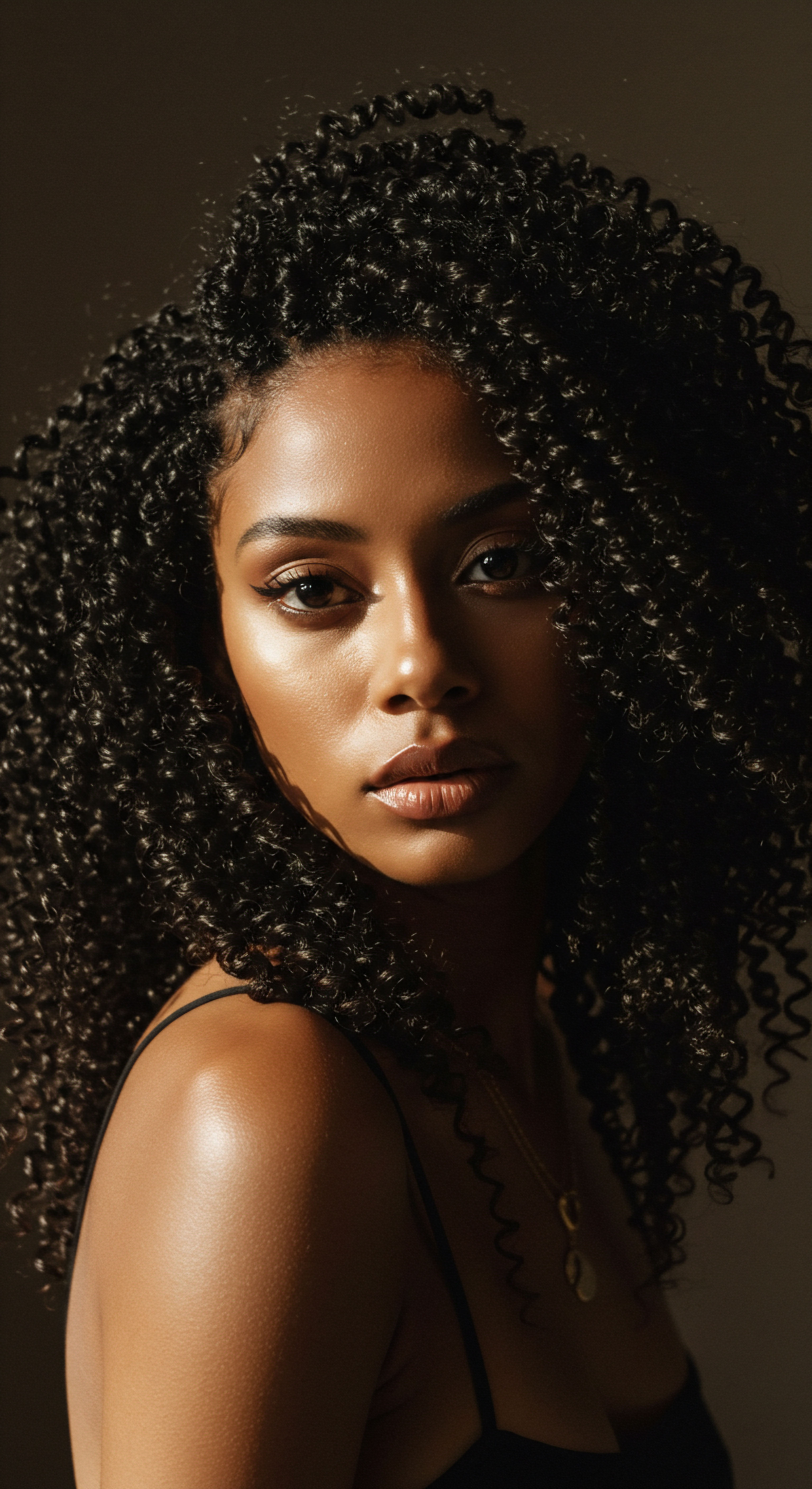
Roots
To truly comprehend what type 3 hair presents, we must first settle into the fundamental understanding of hair itself, moving beyond surface observations. Our hair, a living extension of our very being, carries stories, history, and a delicate blueprint of its formation. Its outward appearance, a cascade of spirals and waves, is a profound reflection of its inner workings, a testament to cellular artistry and the unique dance of proteins within each strand.
Consider the singular hair shaft, a tiny marvel. It is not merely a strand; it is a complex, cylindrical structure, a micro-architectural wonder. At its core, the Medulla, a soft, central channel, may or may not be present, often seen in coarser hair. Surrounding this lies the Cortex, the heart of the hair, composed of keratin proteins arranged in intricate bundles.
These bundles, known as macrofibrils, are the primary contributors to hair’s strength, elasticity, and color. The way these keratin proteins coil and align within the cortex largely dictates the hair’s ultimate shape. The outermost layer, the Cuticle, resembles overlapping shingles on a roof, protecting the inner cortex from damage and regulating moisture. The condition of these cuticular scales significantly impacts how light reflects from the hair and how well it retains hydration.
For type 3 hair, this micro-architecture expresses itself in a distinctive, curvilinear fashion. The follicle from which each strand grows is not perfectly round but rather elliptical or even hook-shaped, guiding the hair into its characteristic ‘S’ or corkscrew patterns as it emerges. This follicular shape dictates the path of the hair shaft, causing it to bend and curve, creating the visible curl.
The distribution of specific cortical cells within the hair shaft also plays a role in this curvature. This cellular arrangement creates an inherent asymmetry, leading to the hair’s natural inclination to curl.
Each individual hair strand is a micro-architectural marvel, its visible curl a direct consequence of its internal structure and the shape of its follicle.
Understanding these foundational elements allows us to appreciate the visual qualities of type 3 hair not as a mere aesthetic, but as a direct outcome of its biological design. It is a hair type that thrives on its unique construction, demanding a care approach that honors its inherent design rather than seeking to alter its natural inclination.

The Anatomy of a Curl
The formation of a curl begins deep within the scalp, where the hair follicle itself holds the key. For straight hair, follicles are typically round, producing cylindrical strands. As the follicle shape becomes more elliptical or even ribbon-like, the hair that emerges begins to curve.
Type 3 hair is born from follicles that are distinctly oval or hook-shaped, guiding the strand into its signature ‘S’ or spiral formations as it grows. This curved pathway means that the hair strand is not uniform in its cross-section along its entire length, contributing to its spring and bounce.
Within the hair shaft, the cortex, a dense layer of keratin proteins, is responsible for the hair’s strength and elasticity. In curly hair, these keratin proteins do not align in a perfectly even, symmetrical pattern. Instead, they are distributed unequally, with certain cell types concentrating on one side of the hair shaft.
This uneven distribution creates tension, compelling the hair to bend and coil. The inner structure, therefore, is in constant, subtle motion, giving rise to the visible curl.

Categorizing Curl Patterns
The Andre Walker Hair Typing System, while not without its discussions, offers a widely recognized framework for describing curl patterns, helping individuals identify and understand their hair. Type 3 hair falls within the “curly” category, distinguished by its defined ‘S’ shaped curls that range from loose, buoyant waves to tight, springy corkscrews.
- Type 3A ❉ This curl pattern presents as large, loose spirals, often resembling a stretched-out ‘S’. The curls possess a noticeable circumference, typically wider than a standard permanent marker. These strands often display a lustrous sheen and a generous bounce.
- Type 3B ❉ Moving to a tighter configuration, Type 3B hair features springier, more defined curls, akin to the size of a sharpie marker. These spirals are often denser and can begin closer to the scalp, creating a fuller appearance.
- Type 3C ❉ At the tighter end of the type 3 spectrum, Type 3C curls are tight, compact corkscrews, often the size of a pencil or straw. These curls are closely packed, contributing to significant volume and density. The definition is often quite pronounced, and the hair can appear quite voluminous.
This classification provides a starting point, a common language for discussing hair textures. Yet, it is important to remember that hair often displays a mixture of patterns across one head, and these categories serve as guides rather than rigid boundaries. The beauty of textured hair lies in its spectrum, its variations, and its personal expression.

Ritual
As we move from the elemental understanding of hair to its lived experience, we begin to appreciate the rhythm of care that brings type 3 hair to its fullest expression. The practices we adopt, the products we choose, and the wisdom we gather become a gentle ritual, shaping not just the appearance of our hair, but also our relationship with it. What does type 3 hair look like when it is cared for with intention, when its unique needs are met with thoughtful attention? It transforms into a vibrant display of its natural beauty, each curl defined, each strand hydrated, radiating a healthy sheen.
Type 3 hair, with its characteristic bends and spirals, often faces challenges in moisture retention. The natural oils produced by the scalp, known as sebum, struggle to travel down the curved shaft as readily as they do on straight strands. This means that type 3 hair can be prone to dryness, leading to a loss of definition and a more expansive, less compact form often described as frizz. Therefore, the core of any effective ritual for type 3 hair centers on providing and sealing in hydration.
A thoughtful cleansing routine begins with gentle, sulfate-free cleansers that purify without stripping precious moisture. Following this, a rich, conditioning treatment becomes paramount, infusing the hair with humectants and emollients that draw in and hold water. The application of styling products, such as curl creams, gels, or mousses, while the hair is still damp, helps to clump the curls together, enhancing their natural pattern and minimizing disruption to the cuticle. This practice encourages the formation of well-defined spirals, allowing the hair to dry with reduced frizz and increased bounce.
Intentional care rituals, centered on hydration and gentle styling, unveil the full, vibrant expression of type 3 hair’s natural beauty.
Drying methods also play a significant role. Air drying or using a diffuser on a low heat setting helps to preserve the curl pattern and reduce the potential for frizz. The delicate nature of type 3 curls means that harsh towel drying or aggressive brushing can disrupt the curl formation, leading to a less cohesive appearance. Instead, gentle squeezing with a microfiber towel or an old cotton t-shirt helps to absorb excess water without disturbing the curls.
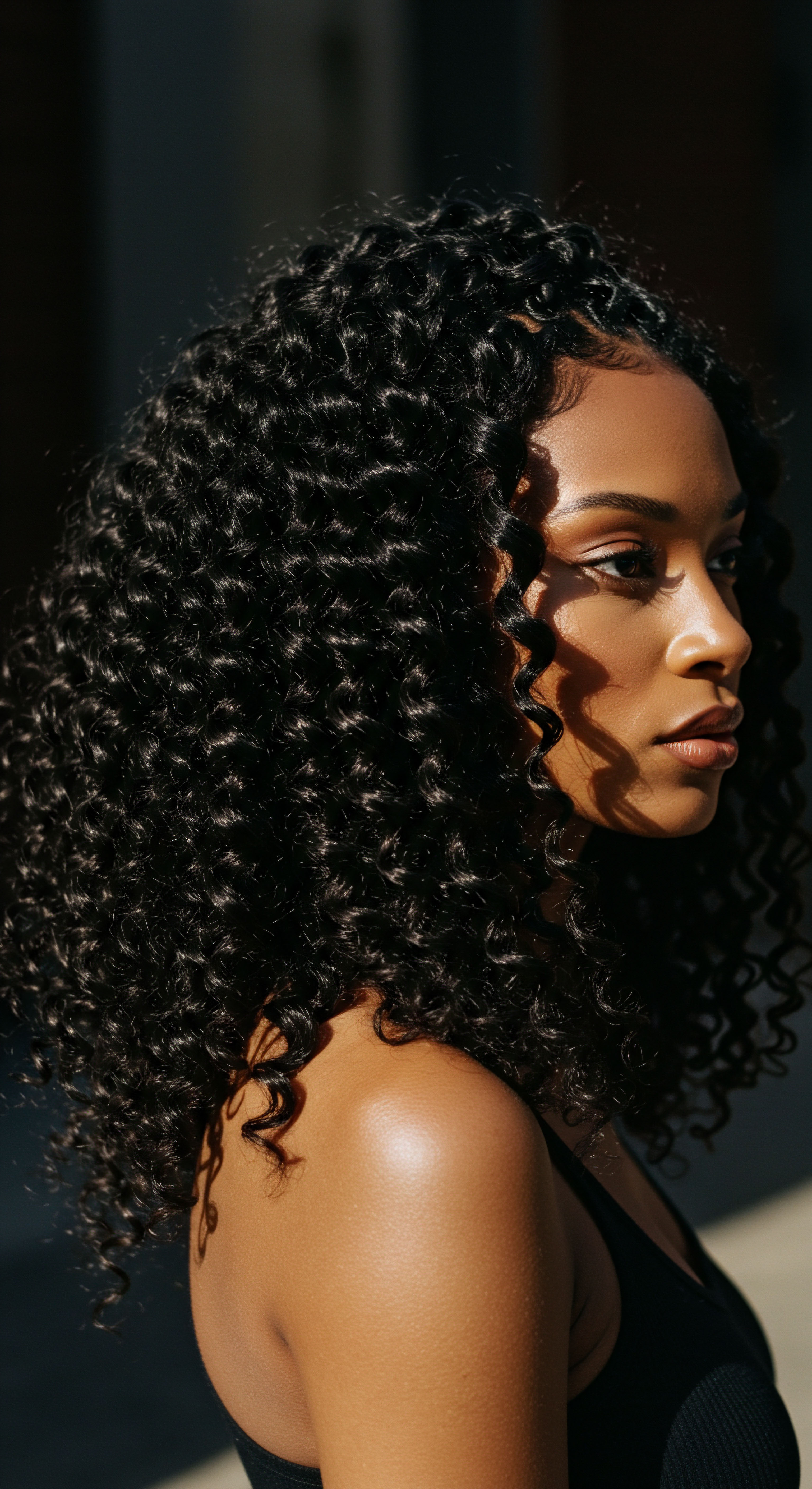
Hydration Strategies for Type 3 Curls
The unique architecture of type 3 hair, with its curvilinear path, means that natural scalp oils often struggle to coat the entire length of the strand. This inherent dryness makes thoughtful hydration a cornerstone of care. Without adequate moisture, the hair cuticle, which normally lies flat, can lift, leading to a rougher surface and a more diffuse, less defined appearance.
Effective hydration for type 3 hair involves a multi-layered approach:
- Water-Based Cleansers ❉ Opt for cleansers that are gentle and do not contain harsh sulfates, which can strip the hair of its natural moisture. Cleansing should focus on the scalp, allowing the lather to rinse through the lengths.
- Conditioning Treatments ❉ After cleansing, a generous application of a hydrating conditioner is essential. Look for ingredients like shea butter, argan oil, or glycerin, which are known for their moisturizing properties. These should be applied from mid-lengths to ends, gently detangling the hair while saturated.
- Leave-In Moisture ❉ A leave-in conditioner or a curl cream applied to damp hair provides a foundational layer of hydration that stays with the hair throughout the day. This helps to seal the cuticle and keep the curls supple.
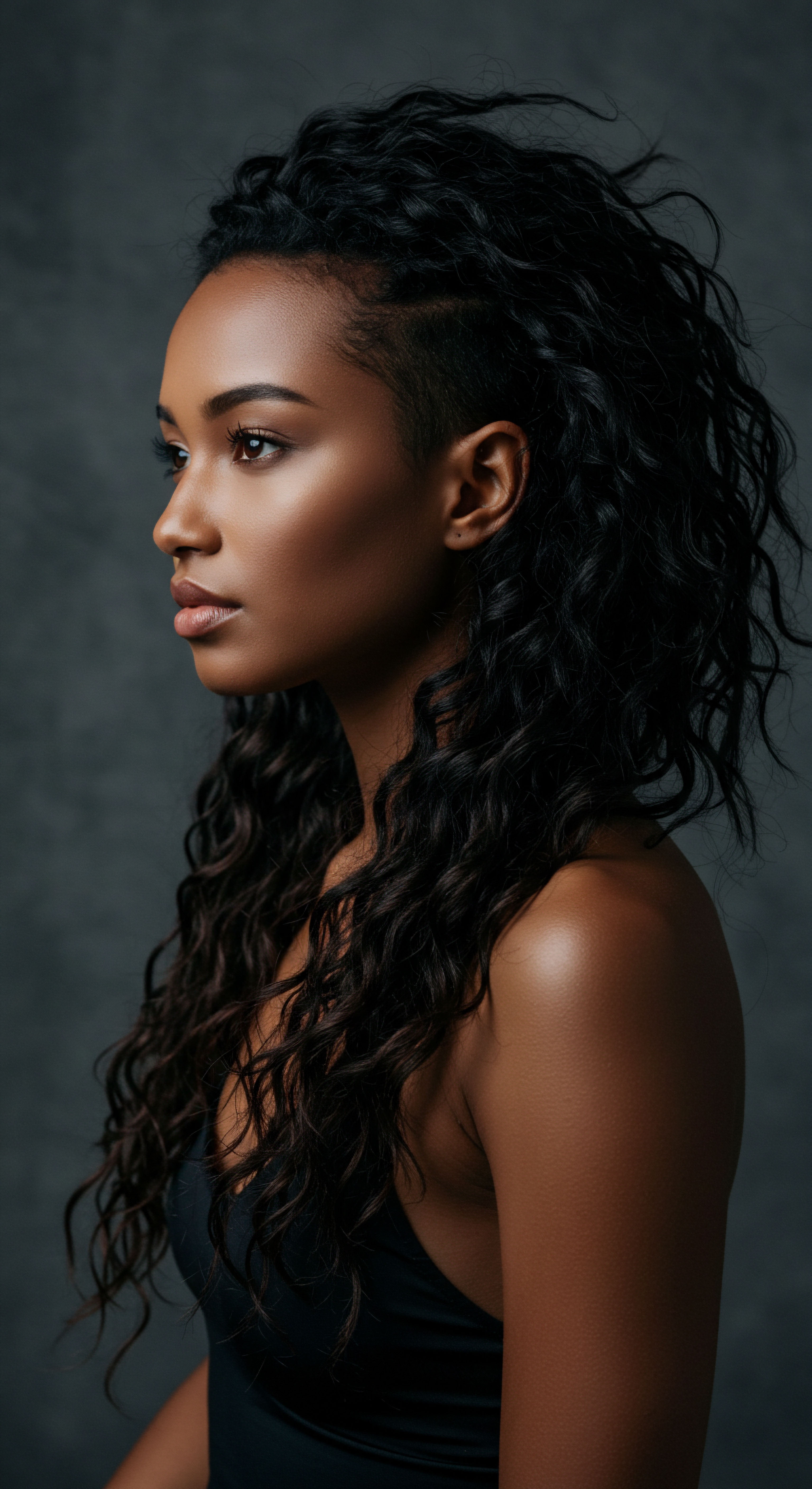
Styling for Definition and Shape
Once hydrated, the next step in the ritual is to encourage and set the curl pattern. The goal is to minimize manipulation while the hair is drying, allowing the curls to form undisturbed.
Techniques to consider:
- Finger Coiling ❉ For areas where curls need more encouragement, gently wrap individual clumps of hair around a finger to define the spiral.
- Scrunching ❉ After applying styling products, gently scrunch the hair upwards towards the scalp. This helps to compress the curl pattern and enhance bounce.
- Diffusing ❉ Using a diffuser attachment on a hairdryer, set to a low heat and low speed, helps to dry the hair evenly while preserving the curl pattern. Hover the diffuser around the head, or gently cup sections of hair within the diffuser bowl.
| Step Gentle Cleansing |
| Purpose Removes impurities without stripping moisture |
| Key Product/Technique Sulfate-free shampoo |
| Step Deep Conditioning |
| Purpose Replenishes hydration and softens strands |
| Key Product/Technique Rich conditioner or hair mask |
| Step Leave-In Application |
| Purpose Provides lasting moisture and detangling ease |
| Key Product/Technique Hydrating leave-in conditioner |
| Step Curl Definition |
| Purpose Enhances natural curl pattern and reduces frizz |
| Key Product/Technique Curl cream or gel, scrunching |
| Step Drying |
| Purpose Preserves curl shape and volume |
| Key Product/Technique Air dry or diffuse on low heat |
| Step Consistency in these practices helps reveal the best appearance of type 3 hair. |
These practices, when consistently applied, reveal type 3 hair in its most serene state ❉ curls that are soft to the touch, visibly defined, and full of life. It is a daily acknowledgment of the hair’s intrinsic needs, allowing its natural beauty to flourish.

Relay
To truly understand what type 3 hair looks like, we must extend our inquiry beyond mere visual description and daily rituals, stepping into a more expansive landscape where science, culture, and personal perception converge. How does the very fabric of type 3 hair respond to the world around it, and what unspoken stories does its appearance tell? This exploration invites us to consider the intricate dance between internal biological structures and external influences, revealing layers of meaning often overlooked.
At a microscopic level, the inherent structure of type 3 hair presents a paradox. While its visible curl may suggest a delicate nature, prone to breakage, scientific inquiry offers a more nuanced perspective. Research into the biomechanical properties of hair has revealed that curly fibers exhibit a distinct “toe region” in their stress-strain plot, a characteristic largely absent in straight hair. This “toe region” represents the initial, relatively low force required to uncoil the natural curve of the hair before it begins to stretch elastically.
This unique behavior indicates that the hair fiber stores mechanical energy within its natural curl, contributing significantly to its overall tensile strength, its ability to resist breaking under tension. This challenges a common misconception that curly hair is inherently weaker than straight hair, suggesting that its perceived fragility may sometimes be linked to handling methods or external factors rather than an intrinsic structural weakness. The “springiness” of type 3 curls, therefore, is not merely an aesthetic quality but a mechanical attribute contributing to its resilience.
Beyond its internal mechanics, the interaction of type 3 hair with its environment profoundly shapes its appearance. Humidity, for instance, acts as a dynamic sculptor. Hair is hygroscopic, meaning it readily absorbs moisture from the air. For type 3 hair, with its often raised cuticle scales, this absorption can lead to swelling of the hair shaft and a disruption of the cuticle layer.
This phenomenon, commonly observed as “frizz,” is a direct consequence of the hair striving to achieve equilibrium with the surrounding moisture. While often viewed as a hair concern, frizz is, in essence, a natural expression of type 3 hair’s responsiveness to its environment, a visual cue of its porous nature. A study on the effect of relative humidity on hair properties indicated that at high humidity (70-95% RH), there are reproducible differences in tensile properties correlated with hair curl type, and even an increase in the denaturation temperature of hair proteins, pointing to structural changes under humid conditions. The length of human hair can even increase by 2 to 2.5% when relative humidity shifts from 0 to 100%. This constant exchange with atmospheric moisture means that the “look” of type 3 hair is never static; it breathes with the air around it.
Type 3 hair’s unique “toe region” in stress-strain tests reveals a hidden strength, challenging common perceptions of its fragility.
The perception of type 3 hair, how it is seen and valued, also forms a significant part of its visual identity. Historically, and even in contemporary contexts, non-straight hair has faced societal biases, often failing to align with Eurocentric beauty ideals that favor straight textures. This can lead to a phenomenon where the natural, voluminous appearance of type 3 hair is misconstrued as “unruly” or “unprofessional,” rather than celebrated for its inherent beauty and unique patterns.
A multinational study on hair types and their impact on daily life indicated that individuals with curly hair, particularly in certain regions, experienced higher stress levels and lower well-being, influenced by societal perceptions of beauty. This external gaze, the cultural lens through which hair is viewed, can inadvertently shape how individuals with type 3 hair perceive their own strands, sometimes leading to attempts to alter its natural form.
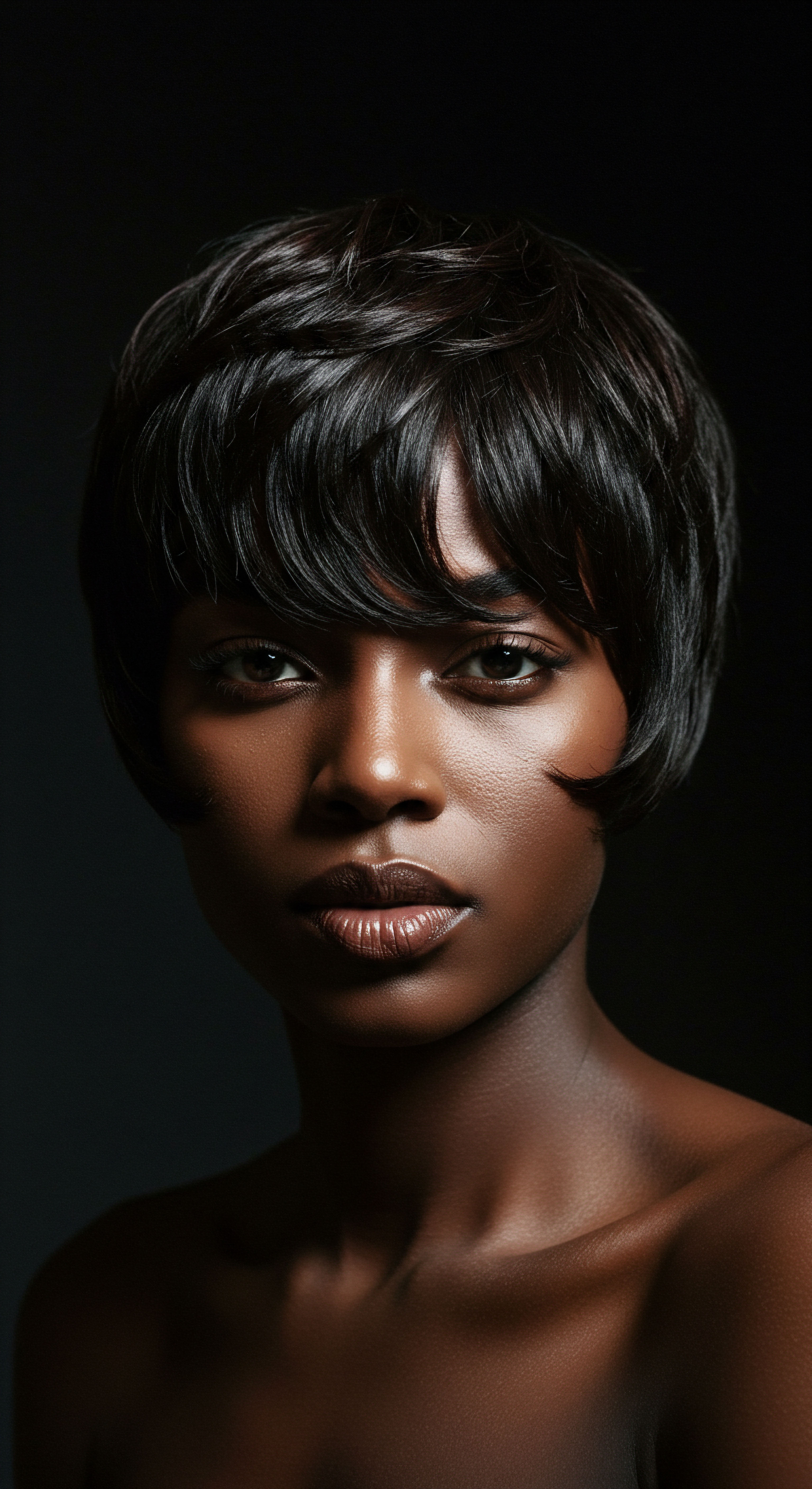
How Does Follicle Shape Guide Curl Formation?
The shape of the hair follicle, nestled beneath the scalp’s surface, is the primary determinant of hair’s curl pattern. For type 3 hair, these follicles are typically elliptical or oval, rather than perfectly round. As the hair shaft grows from this non-circular opening, it is forced to bend and twist, creating the characteristic ‘S’ shapes and spirals.
This is not a random occurrence but a biologically programmed trajectory, influencing the hair’s behavior from its very root. The angle at which the follicle emerges from the scalp also contributes to the direction and tightness of the curl.
Furthermore, internal asymmetries within the hair shaft itself contribute to the curl. Studies using Advanced microscopy have shown that the distribution of cortical cells within curly hair is often bilateral, meaning there are different types of cells or different arrangements of proteins on opposing sides of the hair shaft. This uneven cellular arrangement creates differential growth and tension, compelling the hair to curve. This phenomenon, which appears to be independent of ethnic origin, provides a deeper understanding of the intrinsic forces that give type 3 hair its distinctive form.

The Interplay of Structure and Environment
Type 3 hair’s visual qualities are in constant dialogue with its surroundings. Its unique structural properties, combined with environmental factors, create a dynamic appearance.
- Porosity and Hydration ❉ The cuticle layers of curly hair tend to be more lifted, making the hair more porous. This means it can absorb moisture quickly but also lose it just as rapidly. This leads to the need for consistent hydration to maintain curl definition and prevent dryness.
- Humidity Response ❉ As noted, humidity significantly impacts type 3 hair. The absorption of atmospheric water causes the hair shaft to swell, and if the cuticle is not smooth, this can lead to the visible “frizz” where individual strands stand apart from the main curl pattern. Conversely, in very dry environments, type 3 hair can become brittle and lose its elasticity.
- Elasticity and Bounce ❉ The natural spring of type 3 curls is a direct reflection of its elasticity. When healthy, type 3 hair should stretch and then return to its original coiled shape. This elasticity is what gives type 3 hair its characteristic bounce and movement.
The true appearance of type 3 hair, therefore, is not a static image but a living, breathing expression of its genetic blueprint, its internal cellular architecture, and its ongoing interaction with the world. It is a hair type that invites observation, understanding, and a deep appreciation for its inherent dynamism.
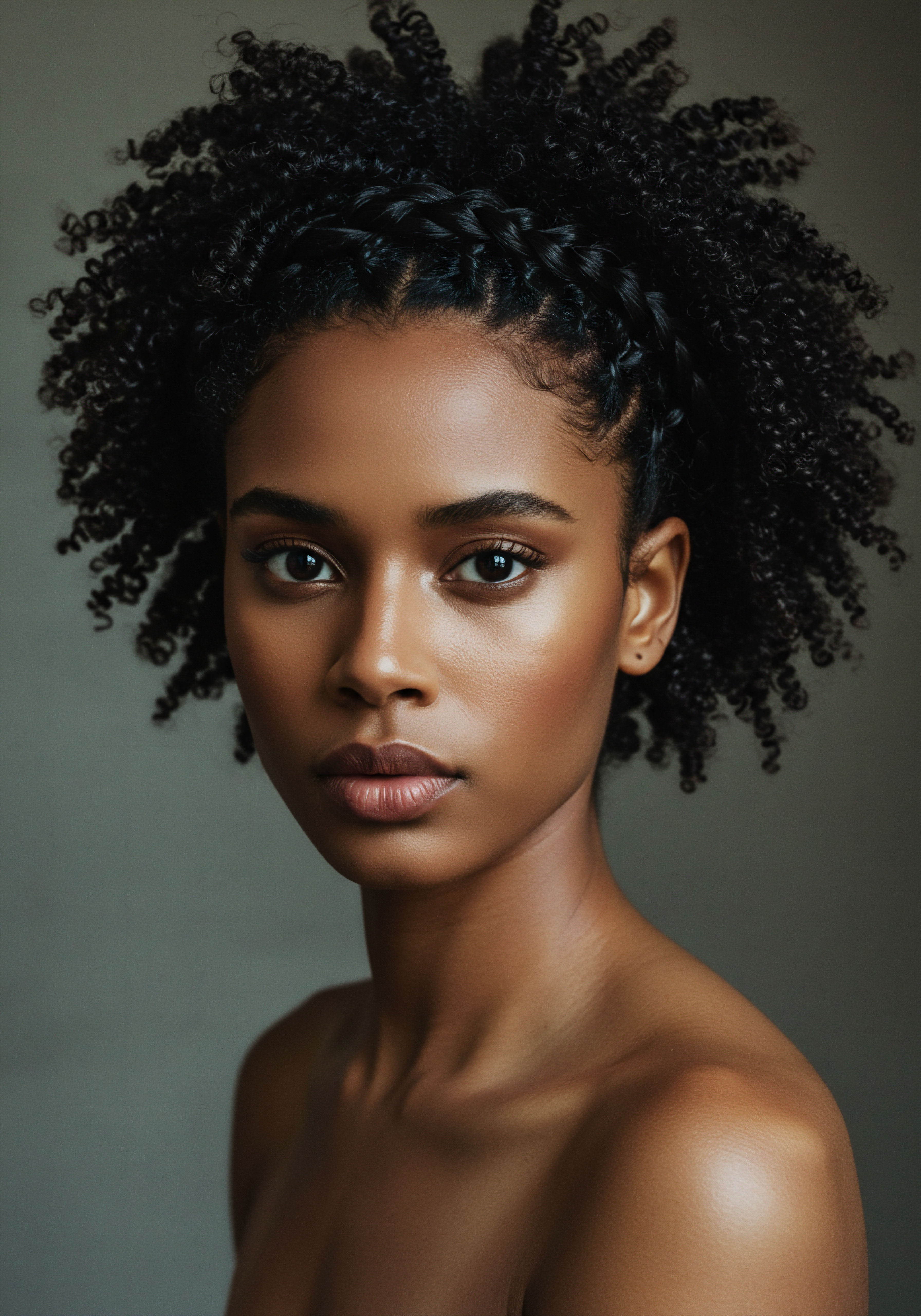
Reflection
To gaze upon type 3 hair is to witness a profound expression of individuality, a symphony of spirals and waves that dance with light and air. It is a reminder that beauty resides not in uniformity, but in the celebration of unique patterns, each curl a testament to a distinct genetic narrative. This hair, in its myriad forms, invites us to look beyond simplistic definitions, to seek the intricate science within and the rich cultural stories that have shaped its perception. As we learn to understand its delicate balance of strength and vulnerability, its responsive nature to the elements, we move closer to a deeper respect for all textures, recognizing in each strand a reflection of life’s boundless variety.
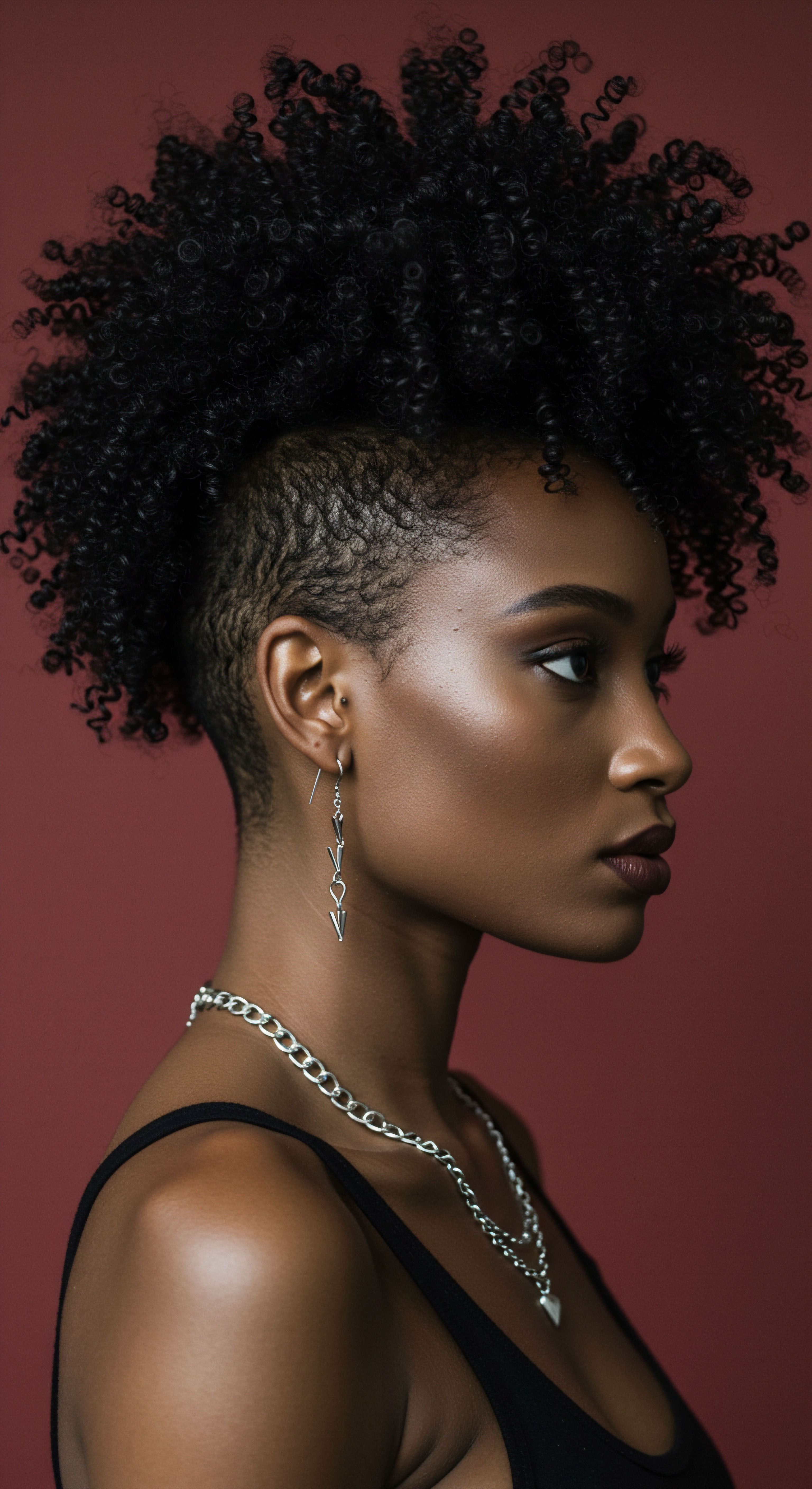
References
- Colete, M. et al. (2019). Understanding Curly Hair Mechanics ❉ Fiber Strength. Journal of Investigative Dermatology, 139(9), S224.
- Bryson, J. M. et al. (2000). The morphology of human hair ❉ a comparative study of straight and curly hair. Journal of Anatomy, 196(Pt 2), 159-168.
- The what, why and how of curly hair ❉ a review. (2019). Proceedings of the Royal Society A ❉ Mathematical, Physical and Engineering Sciences, 475(2232), 20190532.
- Colete, M. et al. (2020). A New Approach to Classify Curly Hair Phenotypes via New Quantitative Metrics. ChemRxiv.
- The what, why and how of curly hair ❉ a review. (2019). Proceedings of the Royal Society A ❉ Mathematical, Physical and Engineering Sciences, 475(2232), 20190532.
- Franbourg, A. et al. (2003). Current trends in ethnical hair ❉ a review. Journal of the American Academy of Dermatology, 48(4), S115-S119.
- Jo, K. S. et al. (2012). Human hair keratin network and curvature. Experimental Dermatology, 21(6), 450-455.
- Colete, M. et al. (2019). Understanding Curly Hair Mechanics ❉ Fiber Strength. Journal of Investigative Dermatology, 139(9), 2017-2024.
- Mizani. (n.d.). Education ❉ Hair Texture Type 3 (Wavy Hair). Retrieved from Mizani official educational resources.
- Thibaut, S. et al. (2017). How different is human hair? A critical appraisal of the reported differences in global hair fibre characteristics and properties towards defining a more relevant framework for hair type classification. International Journal of Cosmetic Science, 39(6), 577-587.
- Kajiura, T. et al. (2007). Cortical cell types and intermediate filament arrangements correlate with fiber curvature in Japanese human hair. Journal of Structural Biology, 159(3), 397-404.
- Draelos, Z. D. (2011). Hair care. Cosmetic Dermatology ❉ Products and Procedures, 2nd Edition, 259-268.
- HairPalace. (n.d.). Hair Structure Explained. Retrieved from HairPalace Hair Transplant Clinic Hungary educational resources.
- Loussouarn, G. et al. (2019). Types and characteristics of hair across different countries ❉ results of a multinational study on 19,461 individuals. Clinical, Cosmetic and Investigational Dermatology, 12, 1-11.
- Loussouarn, G. et al. (2020). Types and Characteristics of Hair Across the Globe ❉ Results of a Multinational Study on 19461 Individuals. Clinical, Cosmetic and Investigational Dermatology, 13, 1-11.
- Velasco, M. V. R. et al. (2009). The science and history behind curly hair, and their changing perceptions in India and beyond. International Journal of Cosmetic Science, 31(6), 405-412.
- Bhushan, B. (2017). The effect of relative humidity on the tensile and thermal properties of curly hair. Journal of Cosmetic Science, 68(1), 1-12.
- Walker, A. (1997). Andre Talks Hair. Simon & Schuster.
- Robbins, C. R. (2012). Chemical and Physical Behavior of Human Hair (5th ed.). Springer.
- Loussouarn, G. et al. (2019). Types and Characteristics of Hair Across the Globe ❉ Results of a Multinational Study on 19461 Individuals. Clinical, Cosmetic and Investigational Dermatology, 12, 1-11.
- Gomi, K. (2004). Measurement of Humidity. Humidity and Moisture Measurement, 21-42.
- Kothari, C. R. (2004). Research Methodology ❉ Methods and Techniques (2nd ed.). New Age International.
- WebMD. (n.d.). Hair Types ❉ Straight, Wavy, Curly, and Coily. Retrieved from WebMD educational resources.
- The Indian Express. (2023, August 27). The science and history behind curly hair, and their changing perceptions in India and beyond. Retrieved from The Indian Express online publication.
- Porter, R. S. (2005). It’s Not Just Hair ❉ Historical and Cultural Considerations for an Emerging Technology. Chicago-Kent Law Review, 80(1), 297-338.